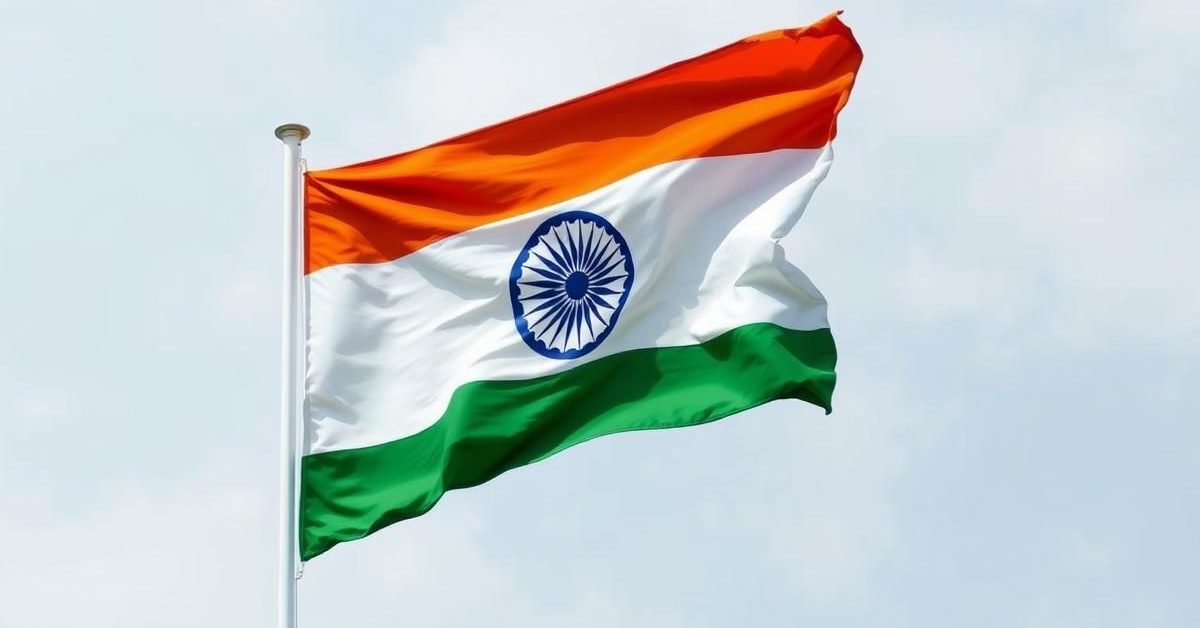India’s national flag, the Tiranga, was officially adopted on July 22, 1947, marking a crucial step towards the nation’s independence.
The Journey to the Tiranga
The concept of a unifying flag for India began to emerge during the early days of the freedom struggle. In 1904, Sister Nivedita proposed an early design featuring red and yellow, symbolizing victory and strength, with “Vande Mataram” inscribed on it.
The first tricolour flag appeared in 1906, showcasing blue, yellow, and red stripes. Subsequent designs included the ‘Calcutta flag’ in 1906, the Berlin flag in 1907 hoisted by Madam Bhikaji Cama, and the Home Rule flag in 1917, each reflecting the growing nationalist sentiment.
As India neared independence in 1947, a special committee led by Dr. Rajendra Prasad was formed to design a flag for the new nation. They decided to modify Pingali Venkayya’s earlier design, which had featured a spinning wheel (charkha). This charkha was replaced by the Ashoka Chakra, leading to the tricolour we know today.
Colours of Meaning and Movement
Each colour and symbol on India’s National Flag carries deep significance, reflecting the nation’s values and aspirations.
The top saffron band represents courage, sacrifice, and the spirit of renunciation. The middle white band signifies purity, truth, and peace, embodying the nation’s commitment to harmony.
The lowermost green band symbolises fertility, growth, and auspiciousness, reflecting India’s agricultural heritage and commitment to environmental well-being.
At the flag’s center is the Ashoka Chakra, a blue wheel with 24 spokes. Inspired by the Dharma Chakra from the Sarnath Lion Capital of Emperor Ashoka, it symbolizes constant movement and progress, signifying that life is in motion and stagnation leads to decline.
Rules and Respect for the National Flag
The use, display, and hoisting of the National Flag are governed by the ‘Flag Code of India 2002,’ which came into effect on January 26, 2002. This code compiles all relevant laws, conventions, and practices.
Any person, organization, or educational institution can hoist or display the Tricolour on any day, provided it aligns with the flag’s dignity and honor. The flag must always be displayed in a position of honor and should not be damaged or disheveled.
The National Flag has a specific dimension ratio: its length to height (width) must always be 3:2. This ensures the flag is always a perfect rectangle.
Regarding its material, an amendment in December 2021 allowed flags to be made from handspun and handwoven or machine-made cotton, polyester, wool, silk, or khadi bunting.
It is illegal to disrespect the flag. According to the Prevention of Insults to National Honour Act, 1971, any act of burning, mutilating, or defiling the flag can lead to imprisonment or a fine. Damaged flags should be destroyed privately, preferably by burning, in a manner consistent with their dignity.
The National Flag cannot be flown on just any vehicle. Its use is restricted to vehicles of the President, Vice President, Prime Minister, Governors, and other specific dignitaries. It should also never be used to cover parts of a vehicle or as a decorative item.
A Fundamental Right to Hoist
In a landmark decision in 2002, the Supreme Court of India declared that the right to hoist the national flag is a fundamental right under Article 19(1)(a) of the Constitution. This emphasizes its profound significance as a symbol of freedom and expression for every Indian citizen.
Pingali Venkayya: The Visionary Behind the Design
The credit for the primary design of the Indian tricolour goes to Pingali Venkayya, an Indian freedom fighter born on August 2, 1876, in Andhra Pradesh. After serving in the British Indian Army in South Africa, he met Mahatma Gandhi and dedicated himself to the freedom movement.
In 1916, Venkayya published a book showcasing 30 different flag designs. At a meeting in Vijayawada in 1921, Mahatma Gandhi approved Venkayya’s initial design, which featured red and green bands with a charkha. On Gandhi’s suggestion, a white band was added. Later, the red was changed to saffron, and the charkha was replaced by the Ashoka Chakra, forming the blueprint for today’s flag.
- The Indian National Flag was adopted by the Constituent Assembly on July 22, 1947.
- Madam Bhikaiji Cama was the first Indian to hoist the Indian flag on foreign soil in 1907.
- The Flag Code of India 2002 governs the display and use of the National Flag.
- The right to hoist the flag is a fundamental right under Article 19(1)(a).
The Tiranga stands as a powerful emblem of India’s independence, unity, and its enduring values.















